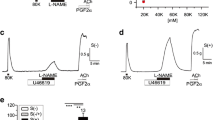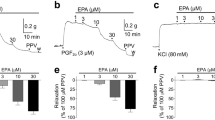Abstract.
In the present study we determined whether the endothelium-derived hyperpolarizing factor (EDHF), in addition to its acute effects on vascular tone, activates intracellular signalling pathways other than those associated with Ca2+-dependent K+ channels. EDHF was generated by rhythmic distension of porcine coronary arteries under conditions of combined nitric oxide (NO) synthase/cyclo-oxygenase blockade, and the EDHF-containing luminal incubate was applied to cultured human coronary endothelial or smooth muscle cells. In both cell types, the luminal incubate activated tyrosine kinases, the mitogen-activated protein (MAP) kinases, extracellular signal regulated kinases 1 and 2 (Erk1/2) and p38, as well as protein kinase B/Akt. The constituent responsible for Erk1/2 phosphorylation was identified as a cytochrome P450 (CYP) metabolite, as Erk1/2 activation was attenuated by pretreating the EDHF donor with the CYP 2C inhibitor sulfaphenazole as well as by CYP 2C antisense oligonucleotides. Erk1/2 phosphorylation in detector cells was also observed following the transfer of supernatant from cultured endothelial cells treated with the CYP inducer β-naphthoflavone. The CYP 2C product 11,12-epoxyeicosatrienoic acid (11,12-EET) also activated tyrosine kinases, Erk1/2 and p38 MAP kinase. Overexpression of CYP 2C8 in native porcine coronary artery endothelial cells resulted in an increase in endothelial 11,12-EET production and Erk1/2 phosphorylation compared to that detected in untreated cells or cells transfected with an antisense CYP 2C8. Endothelial cell number was unaffected by transfection with LacZ or CYP 2C8 antisense but was significantly enhanced in cells overexpressing CYP 2C8. These observations indicate that EDHF/11,12-EET is not simply a vasodilator and that its continuous release under pulsatile conditions in vivo may affect vascular cell signalling and proliferation.
Similar content being viewed by others
Author information
Authors and Affiliations
Additional information
Received after revision: 28 February 2001
Electronic Publication
Rights and permissions
About this article
Cite this article
Fleming, I., Fisslthaler, B., Michaelis, R.U. et al. The coronary endothelium-derived hyperpolarizing factor (EDHF) stimulates multiple signalling pathways and proliferation in vascular cells. Pflügers Arch - Eur J Physiol 442, 511–518 (2001). https://doi.org/10.1007/s004240100565
Received:
Accepted:
Issue Date:
DOI: https://doi.org/10.1007/s004240100565




